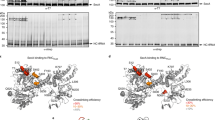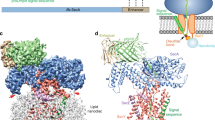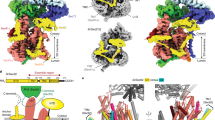Abstract
The biogenesis of secretory as well as transmembrane proteins requires the activity of the universally conserved protein-conducting channel (PCC), the Sec61 complex (SecY complex in bacteria)1. In eukaryotic cells the PCC is located in the membrane of the endoplasmic reticulum where it can bind to translating ribosomes for co-translational protein transport. The Sec complex consists of three subunits (Sec61α, β and γ) and provides an aqueous environment for the translocation of hydrophilic peptides as well as a lateral opening in the Sec61α subunit that has been proposed to act as a gate for the membrane partitioning of hydrophobic domains2. A plug helix and a so-called pore ring are believed to seal the PCC against ion flow and are proposed to rearrange for accommodation of translocating peptides2,3. Several crystal and cryo-electron microscopy structures revealed different conformations of closed and partially open Sec61 and SecY complexes2,4,5,6,7,8. However, in none of these samples has the translocation state been unambiguously defined biochemically. Here we present cryo-electron microscopy structures of ribosome-bound Sec61 complexes engaged in translocation or membrane insertion of nascent peptides. Our data show that a hydrophilic peptide can translocate through the Sec complex with an essentially closed lateral gate and an only slightly rearranged central channel. Membrane insertion of a hydrophobic domain seems to occur with the Sec complex opening the proposed lateral gate while rearranging the plug to maintain an ion permeability barrier. Taken together, we provide a structural model for the basic activities of the Sec61 complex as a protein-conducting channel.
This is a preview of subscription content, access via your institution
Access options
Subscribe to this journal
Receive 51 print issues and online access
$199.00 per year
only $3.90 per issue
Buy this article
- Purchase on Springer Link
- Instant access to full article PDF
Prices may be subject to local taxes which are calculated during checkout




Similar content being viewed by others
Accession codes
Accessions
EMBL/GenBank/DDBJ
Electron Microscopy Data Bank
Protein Data Bank
Data deposits
Cryo-electron microscopy maps for the idle 80S–Sec61 complex, the LepT–RNC–Sec61 complex and the LepM–RNC–Sec61 complex have been deposited in the EMDataBank with accession codes EMD-2510, EMD-2511 and EMD-2512. The respective coordinates for electron-microscopy-based models are deposited in the Protein Data Bank (4CG7, 4CG5 and 4CG6 for the Sec61 complex and 3J5Z, 3J60, 3J62, 3J61 for the updated model of the wheat germ ribosome).
References
Park, E. & Rapoport, T. A. Mechanisms of Sec61/SecY-mediated protein translocation across membranes. Annu. Rev. Biophys. 41, 21–40 (2012)
van den Berg, B. et al. X-ray structure of a protein-conducting channel. Nature 427, 36–44 (2004)
Park, E. & Rapoport, T. A. Preserving the membrane barrier for small molecules during bacterial protein translocation. Nature 473, 239–242 (2011)
Zimmer, J., Nam, Y. & Rapoport, T. A. Structure of a complex of the ATPase SecA and the protein-translocation channel. Nature 455, 936–943 (2008)
Tsukazaki, T. et al. Conformational transition of Sec machinery inferred from bacterial SecYE structures. Nature 455, 988–991 (2008)
Egea, P. F. & Stroud, R. M. Lateral opening of a translocon upon entry of protein suggests the mechanism of insertion into membranes. Proc. Natl Acad. Sci. USA 107, 17182–17187 (2010)
Becker, T. et al. Structure of monomeric yeast and mammalian Sec61 complexes interacting with the translating ribosome. Science 326, 1369–1373 (2009)
Frauenfeld, J. et al. Cryo-EM structure of the ribosome–SecYE complex in the membrane environment. Nature Struct. Mol. Biol. 18, 614–621 (2011)
Erickson, A. H. & Blobel, G. Cell-free translation of messenger RNA in a wheat germ system. Methods Enzymol. 96, 38–50 (1983)
Sääf, A., Wallin, E. & von Heijne, G. Stop-transfer function of pseudo-random amino acid segments during translocation across prokaryotic and eukaryotic membranes. Eur. J. Biochem. 251, 821–829 (1998)
Bhushan, S. et al. Structural basis for translational stalling by human cytomegalovirus and fungal arginine attenuator peptide. Mol. Cell 40, 138–146 (2010)
Degnin, C. R., Schleiss, M. R., Cao, J. & Geballe, A. P. Translational inhibition mediated by a short upstream open reading frame in the human cytomegalovirus gpUL4 (gp48) transcript. J. Virol. 67, 5514–5521 (1993)
Ménétret, J.-F. et al. Single copies of Sec61 and TRAP associate with a nontranslating mammalian ribosome. Structure 16, 1126–1137 (2008)
Ménétret, J.-F. et al. Ribosome binding of a single copy of the SecY complex: implications for protein translocation. Mol. Cell 28, 1083–1092 (2007)
Simon, S. M. & Blobel, G. A protein-conducting channel in the endoplasmic reticulum. Cell 65, 371–380 (1991)
du Plessis, D. J., Berrelkamp, G., Nouwen, N. & Driessen, A. J. The lateral gate of SecYEG opens during protein translocation. J. Biol. Chem. 284, 15805–15814 (2009)
Lycklama a Nijeholt, J. A., Bulacu, M., Marrink, S. J. & Driessen, A. J. Immobilization of the plug domain inside the SecY channel allows unrestricted protein translocation. J. Biol. Chem. 285, 23747–23754 (2010)
Cannon, K. S., Or, E., Clemons, W. M., Jr, Shibata, Y. & Rapoport, T. A. Disulfide bridge formation between SecY and a translocating polypeptide localizes the translocation pore to the center of SecY. J. Cell Biol. 169, 219–225 (2005)
Plath, K., Mothes, W., Wilkinson, B. M., Stirling, C. J. & Rapoport, T. A. Signal sequence recognition in posttranslational protein transport across the yeast ER membrane. Cell 94, 795–807 (1998)
Hizlan, D. et al. Structure of the SecY complex unlocked by a preprotein mimic. Cell Rep. 1, 21–28 (2012)
Sadlish, H., Pitonzo, D., Johnson, A. E. & Skach, W. R. Sequential triage of transmembrane segments by Sec61α during biogenesis of a native multispanning membrane protein. Nature Struct. Mol. Biol. 12, 870–878 (2005)
Pitonzo, D., Yang, Z., Matsumura, Y., Johnson, A. E. & Skach, W. R. Sequence-specific retention and regulated integration of a nascent membrane protein by the endoplasmic reticulum Sec61 translocon. Mol. Biol. Cell 20, 685–698 (2009)
Hou, B., Lin, P. J. & Johnson, A. E. Membrane protein TM segments are retained at the translocon during integration until the nascent chain cues FRET-detected release into bulk lipid. Mol. Cell 48, 398–408 (2012)
Heinrich, S. U. & Rapoport, T. A. Cooperation of transmembrane segments during the integration of a double-spanning protein into the ER membrane. EMBO J. 22, 3654–3663 (2003)
Martoglio, B., Hofmann, M. W., Brunner, J. & Dobberstein, B. The protein-conducting channel in the membrane of the endoplasmic reticulum is open laterally toward the lipid bilayer. Cell 81, 207–214 (1995)
Hessa, T. et al. Recognition of transmembrane helices by the endoplasmic reticulum translocon. Nature 433, 377–381 (2005)
Hessa, T. et al. Molecular code for transmembrane-helix recognition by the Sec61 translocon. Nature 450, 1026–1030 (2007)
Heinrich, S. U., Mothes, W., Brunner, J. & Rapoport, T. A. The Sec61p complex mediates the integration of a membrane protein by allowing lipid partitioning of the transmembrane domain. Cell 102, 233–244 (2000)
Lycklama a Nijeholt, J. A., Wu, Z. C. & Driessen, A. J. Conformational dynamics of the plug domain of the SecYEG protein-conducting channel. J. Biol. Chem. 286, 43881–43890 (2011)
Halic, M. et al. Structure of the signal recognition particle interacting with the elongation-arrested ribosome. Nature 427, 808–814 (2004)
Frank, J. et al. SPIDER and WEB: processing and visualization of images in 3D electron microscopy and related fields. J. Struct. Biol. 116, 190–199 (1996)
Emsley, P. & Cowtan, K. Coot: model-building tools for molecular graphics. Acta Crystallogr. D 60, 2126–2132 (2004)
Pettersen, E. F. et al. UCSF Chimera–a visualization system for exploratory research and analysis. J. Comput. Chem. 25, 1605–1612 (2004)
Walter, P., Ibrahimi, I. & Blobel, G. Translocation of proteins across the endoplasmic reticulum. I. Signal recognition protein (SRP) binds to in-vitro-assembled polysomes synthesizing secretory protein. J. Cell Biol. 91, 545–550 (1981)
Görlich, D. & Rapoport, T. A. Protein translocation into proteoliposomes reconstituted from purified components of the endoplasmic reticulum membrane. Cell 75, 615–630 (1993)
Martoglio, B. H. S. and Dobberstein, B. in Cell Biology: A Laboratory Handbook 2nd edn (ed J. E. Celis ) Vol. 1,. 265–273 (1997)
Wagenknecht, T., Grassucci, R. & Frank, J. Electron microscopy and computer image averaging of ice-embedded large ribosomal subunits from Escherichia coli . J. Mol. Biol. 199, 137–147 (1988)
Chen, J. Z. & Grigorieff, N. SIGNATURE: a single-particle selection system for molecular electron microscopy. J. Struct. Biol. 157, 168–173 (2007)
Norousi, R. et al. Automatic post-picking using MAPPOS improves particle image detection from cryo-EM micrographs. J. Struct. Biol. 182, 59–66 (2013)
Söding, J., Biegert, A. & Lupas, A. N. The HHpred interactive server for protein homology detection and structure prediction. Nucleic Acids Res. 33, W244–W248 (2005)
Eswar, N., Eramian, D., Webb, B., Shen, M. Y. & Sali, A. Protein structure modeling with MODELLER. Methods Mol. Biol. 426, 145–159 (2008)
Armache, J. P. et al. Cryo-EM structure and rRNA model of a translating eukaryotic 80S ribosome at 5.5 Å resolution. Proc. Natl Acad. Sci. USA 107, 19748–19753 (2010)
Armache, J. P. et al. Localization of eukaryote-specific ribosomal proteins in a 5.5 Å cryo-EM map of the 80S eukaryotic ribosome. Proc. Natl Acad. Sci. USA 107, 19754–19759 (2010)
Ben-Shem, A. et al. The structure of the eukaryotic ribosome at 3.0 Å resolution. Science 334, 1524–1529 (2011)
Trabuco, L. G., Villa, E., Mitra, K., Frank, J. & Schulten, K. Flexible fitting of atomic structures into electron microscopy maps using molecular dynamics. Structure 16, 673–683 (2008)
Acknowledgements
We thank C. Ungewickell for assistance with cryo-electron microscopy, E. van der Sluis for discussions, S. Funes for help with reagent preparation, B. Dobberstein for endoplasmic reticulum membranes, F. Förster and S. Pfeffer for performing mass spectrometry analysis. This work was supported by grants of the German Research Council (SFB594 to R.B. and B.B., SFB646 to T.B. and R.B., GRK1721 to R.B.). R.B. acknowledges support by the Center for Integrated Protein Science and the European Research Council (Advanced Grant CRYOTRANSLATION).
Author information
Authors and Affiliations
Contributions
M.G., T.B. and R.B. designed the study. M.G. established protocols for generation of translocation and insertion intermediates, processed and interpreted the cryo-electron microscopy structures, M.G and T.B built molecular models for the Sec61 complex and prepared all figures. B.B. prepared SRP and assisted in preparing wheat germ translation extract and PKRM. J.-P.A. assisted in data processing, C.B.-G. built a refined model of the wheat germ ribosome. O.B. performed cryo-electron microscopy data collection, M.G., T.B. and R.B. interpreted results and wrote the paper.
Corresponding author
Ethics declarations
Competing interests
The authors declare no competing financial interests.
Extended data figures and tables
Extended Data Figure 1 Western blot and mass spectrometry analysis of the purified LepM sample.
Protein content and western blot analysis of the LepM-purification of LepM-containing RNC–Sec61 complexes for flow through (Ft, left) and elution (E, right) fractions. a, Blot probing for the haemagglutinin-tagged nascent chain of LepM. Glycosylated peptidyl-tRNA (Gly-PtRNA, *), unglycosylated peptidyl-tRNA (ut), glycosylated free peptide (gp), unglycosylated free peptide (up) and degradation bands (deg) are indicated. b, Blot probing for the Sec61α protein (*). c, Same as a, but with a mock purification using streptavidin beads pre-saturated with desthiobiotin to determine the level of nonspecific binding to the beads. d, Ribosomal proteins and subunits of the Sec61 complex identified in the sample by mass spectrometry. Ribosomal proteins of the large subunit are in grey, of the small subunit yellow and subunits of the Sec61 complex are highlighted in red.
Extended Data Figure 2 Cryo-electron microscopy reconstructions of ribosome–PCC complexes and resolution curves.
Cryo-electron microscopy maps of the idle 80S–Sec61 complex (left), the LepT–RNC–Sec61 complex (middle) and the LepM–RNC–Sec61 complex (right) at 6.9 Å, 7.4 Å and 7.8 Å, respectively, according to the Fourier shell correlation at cutoff 0.5.
Extended Data Figure 3 Fourier shell correlation curves between experimental maps and molecular models.
Left, Fourier shell correlation curves between the updated model for the wheat germ ribosome with the empty 80S–Sec61 map, the LepT–RNC–Sec61 map and the LepM–RNC–Sec61 map. Right, Fourier shell correlation curves between the models for empty, LepT- and LepM-engaged Sec61 and respective densities, which were cut out using a soft mask.
Extended Data Figure 4 Model for mammalian (Canis familiaris) Sec61 complexes bound to the wheat germ (Triticum aestivum) ribosome.
a, Left panel, fitting of the idle 80S–Sec61 complex. For ribosomal proteins and RNA a refined model of the wheat germ 80S ribosome45 was used. Right panel, isolated density for the Sec61 complex without the mixed detergent/lipid micelle. Views are: front view focusing on the lateral gate (TM2 and TM7), cytoplasmic view and side view focusing on the plug. b, As in a for the translocating LepT–RNC–Sec61 complex. c, As in a for the inserting LepM–RNC–Sec61 complex. The extra transmembrane segment belonging to the variable region of LepM is indicated (green; TM).
Extended Data Figure 5 Comparison of Sec61 models with available crystal structures and cryo-electron microscopy models.
a, Model for the idle Sec61 complex. b, Idle Sec61 compared to Methanococcus jannaschii crystal structure of SecYEβ2. c, Idle Sec61 compared to Sec61 in-vitro-reconstituted with a translating ribosome with a type II signal-anchor sequence7. d, Model for the LepT-engaged Sec61 complex. e, LepT–Sec61 compared to Thermotoga maritima crystal structure of SecYEG bound to SecA4. f, LepT–Sec61 compared to Sec61 as in c. g, Model for the LepM-engaged Sec61 complex. h, Model for Escherichia coli SecYE embedded in native membrane environment (nanodiscs) bound to a translating ribosome and a signal-anchor sequence8. i, LepM–Sec61 compared to Pyrococcus furiosus crystal structure of SecYE6. In all comparison images colours for idle and engaged Sec61 are as in a and TM10 is shown in magenta. For better clarity TM10 is shown in pink and the plug in pale green for the referenced Sec complexes we compare with our structures.
Extended Data Figure 6 Model for a peptide translocating through LepT–Sec61.
a, Cytoplasmic view and b, side view focusing on the plug and TM10. A poly-alanine model peptide (green) has been placed, showing that in principle there is enough space between plug, TM5 and TM10 to accommodate an extended translocating nascent chain. The path of the model peptide through the Sec61 complex has been arbitrarily placed and alternative routes, especially above and below the central pore ring, are possible. NC, nascent chain.
Rights and permissions
About this article
Cite this article
Gogala, M., Becker, T., Beatrix, B. et al. Structures of the Sec61 complex engaged in nascent peptide translocation or membrane insertion. Nature 506, 107–110 (2014). https://doi.org/10.1038/nature12950
Received:
Accepted:
Published:
Issue Date:
DOI: https://doi.org/10.1038/nature12950
This article is cited by
-
Transgene-induced cell death following dengue-2 virus infection in Aedes aegypti
Scientific Reports (2023)
-
A common mechanism of Sec61 translocon inhibition by small molecules
Nature Chemical Biology (2023)
-
Comparative iTRAQ proteomics identified proteins associated with sperm maturation between yak and cattleyak epididymis
BMC Veterinary Research (2021)
-
The aftermath of the interplay between the endoplasmic reticulum stress response and redox signaling
Experimental & Molecular Medicine (2021)
-
Disruption of vacuolar protein sorting components of the HOPS complex leads to enhanced secretion of recombinant proteins in Pichia pastoris
Microbial Cell Factories (2019)
Comments
By submitting a comment you agree to abide by our Terms and Community Guidelines. If you find something abusive or that does not comply with our terms or guidelines please flag it as inappropriate.



